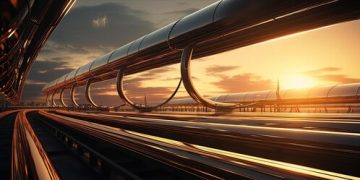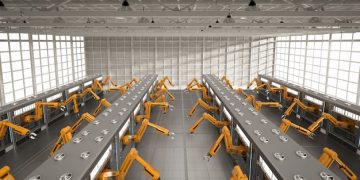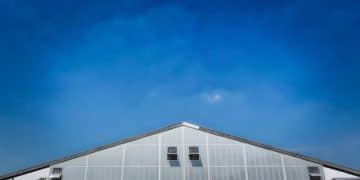US Infrastructure: Latest Developments and Life Impact

The latest developments in US infrastructure, spurred by the Bipartisan Infrastructure Law, encompass improvements in roads, bridges, public transit, broadband internet access, and clean energy initiatives, aiming to modernize the nation’s infrastructure and enhance daily life for its citizens.
The United States is undergoing a significant transformation in its infrastructure landscape. Recent developments, largely fueled by the Bipartisan Infrastructure Law, are poised to reshape the way Americans live, work, and travel. Understanding what are the latest developments in US infrastructure and how will they impact your life is crucial for navigating the changes ahead.
Investing in America’s Future: Key Infrastructure Areas
The Bipartisan Infrastructure Law, signed into law in 2021, represents a historic investment in America’s infrastructure. It allocates significant funding to address critical needs across various sectors, aiming to modernize and upgrade the nation’s aging infrastructure.
This comprehensive plan focuses on several key areas, including transportation, water infrastructure, broadband internet, and energy. These investments are not merely about repairing what’s broken; they are about building a foundation for future economic growth and improved quality of life.
Roads and Bridges: A Foundation of Connectivity
A substantial portion of the infrastructure bill is dedicated to repairing and upgrading roads and bridges. With thousands of bridges in need of repair and roadways facing increasing congestion, these investments are vital for ensuring safe and efficient transportation.
Modernizing roads and bridges also includes incorporating smart technologies to improve traffic flow and reduce accidents. This involves implementing advanced traffic management systems, connected vehicle technology, and real-time data collection for better decision-making.
Public Transit: Expanding Access and Reducing Emissions
Investing in public transit is another key priority. Expanding access to public transportation can reduce traffic congestion, lower greenhouse gas emissions, and provide affordable mobility options for millions of Americans. The bill includes funding for new buses and trains, expanded rail lines, and improved accessibility for people with disabilities.
These transit improvements aim to connect communities, create job opportunities, and promote sustainable transportation practices. By providing efficient and reliable public transit options, the infrastructure bill seeks to reduce reliance on personal vehicles and create more livable cities.
- Repairing and modernizing existing roads and bridges
- Expanding public transit options in urban and rural areas
- Investing in clean energy technologies for transportation
- Creating jobs and stimulating economic growth through infrastructure projects
The infrastructure bill’s commitment to modernizing transportation infrastructure will have a lasting impact. By addressing critical needs and embracing innovative technologies, the US is positioning itself for a future of sustainable and efficient transportation.
Broadband Expansion: Bridging the Digital Divide
Access to high-speed internet has become essential in the 21st century. The digital divide, which separates those with access to broadband from those without, has significant implications for education, employment, and healthcare. The infrastructure bill aims to bridge this gap by expanding broadband access to underserved communities.
The plan focuses on deploying broadband infrastructure in rural and remote areas, as well as providing subsidies to low-income households to help them afford internet service. This investment is crucial for ensuring that all Americans have the opportunity to participate in the digital economy.
Closing the Gap in Rural America
Rural areas often lack the infrastructure necessary to support high-speed internet. The infrastructure bill provides funding for building new broadband networks and upgrading existing ones in these areas. This will enable rural residents to access online education, telehealth services, and remote work opportunities.
Expanding broadband access in rural America is not just about convenience; it’s about creating economic opportunities and improving the quality of life for rural communities. It allows small businesses to compete in the global marketplace and provides residents with access to essential services.
Affordable Connectivity for All
Even in areas where broadband infrastructure exists, many low-income families struggle to afford internet service. The infrastructure bill includes provisions to provide subsidies to these households, making internet access more affordable and accessible.
This affordable connectivity program helps to level the playing field, ensuring that low-income families have the same opportunities as their wealthier counterparts. It also promotes digital literacy and helps to close the achievement gap in education.

- Deploying broadband infrastructure in rural and underserved areas
- Providing subsidies to low-income households to make internet access more affordable
- Promoting digital literacy and skills training
- Closing the digital divide and creating economic opportunities
By prioritizing broadband expansion, the infrastructure bill aims to create a more connected and equitable society. This investment will have a profound impact on education, employment, and healthcare, improving the lives of millions of Americans.
Modernizing Water Infrastructure: Ensuring Clean and Safe Water
Access to clean and safe drinking water is a fundamental human right. However, many communities across the US face challenges related to aging water infrastructure, lead contamination, and water scarcity. The infrastructure bill addresses these issues by investing in modernizing water infrastructure.
The plan includes funding for replacing lead pipes, upgrading water treatment plants, and improving water conservation efforts. These investments are crucial for protecting public health and ensuring a sustainable water supply for future generations.
Replacing Lead Pipes: Protecting Public Health
Lead contamination in drinking water is a serious health hazard, particularly for children. The infrastructure bill allocates significant funding to replace lead pipes and eliminate this source of contamination. This will protect the health of millions of Americans and prevent future health problems.
Replacing lead pipes is a complex and expensive undertaking, but it is a necessary investment in public health. The infrastructure bill provides the resources needed to address this issue and ensure that all Americans have access to safe drinking water.
Upgrading Water Treatment Plants: Ensuring Water Quality
Many water treatment plants in the US are outdated and in need of repair. The infrastructure bill provides funding for upgrading these plants, ensuring that they can effectively remove contaminants and provide clean, safe drinking water.
Upgrading water treatment plants also includes incorporating new technologies to improve water quality and reduce energy consumption. This will help to ensure a sustainable water supply and protect the environment.
- Replacing lead pipes to eliminate lead contamination in drinking water
- Upgrading water treatment plants to ensure water quality
- Investing in water conservation efforts to address water scarcity
- Protecting public health and ensuring a sustainable water supply
By modernizing water infrastructure, the infrastructure bill helps to create healthier communities and protect the environment. This investment will have a lasting impact on the quality of life for millions of Americans.
Investing in Clean Energy and Resilience
The infrastructure bill recognizes the importance of transitioning to a clean energy economy and building resilience to climate change. It includes investments in renewable energy, electric vehicle infrastructure, and grid modernization. These investments will help to reduce greenhouse gas emissions, create jobs, and protect communities from the impacts of climate change.
The plan focuses on developing clean energy sources, improving energy efficiency, and building resilient infrastructure that can withstand extreme weather events. This will help to create a more sustainable and prosperous future for all Americans.
Renewable Energy: Powering a Cleaner Future
The infrastructure bill provides funding for developing and deploying renewable energy technologies, such as solar, wind, and geothermal. This will help to reduce reliance on fossil fuels and create a cleaner energy future.
Investing in renewable energy also creates jobs in manufacturing, installation, and maintenance. This will help to stimulate economic growth and create new opportunities for workers across the US.
Electric Vehicle Infrastructure: Supporting the Transition to EVs
The infrastructure bill includes funding for building a national network of electric vehicle charging stations. This will make it easier for Americans to switch to electric vehicles, reducing greenhouse gas emissions and improving air quality.
Investing in electric vehicle infrastructure also supports the growth of the electric vehicle industry, creating jobs and stimulating innovation. This will help to accelerate the transition to a clean transportation system.

- Developing and deploying renewable energy technologies
- Building a national network of electric vehicle charging stations
- Modernizing the electric grid to improve reliability and resilience
- Reducing greenhouse gas emissions and creating a cleaner energy future
By investing in clean energy and resilience, the infrastructure bill helps to create a more sustainable and prosperous future for all Americans. This investment will reduce greenhouse gas emissions, create jobs, and protect communities from the impacts of climate change.
Job Creation and Economic Growth
The infrastructure bill is not just about fixing roads and bridges; it’s about creating jobs and stimulating economic growth. The investments in infrastructure will create millions of jobs in construction, manufacturing, and related industries. These jobs will provide opportunities for workers across the US and help to boost the economy.
The plan also includes provisions to ensure that these jobs are accessible to workers from all backgrounds, including women, minorities, and veterans. This will help to create a more equitable and inclusive economy.
Construction Jobs: Rebuilding America
The infrastructure bill will create millions of construction jobs as roads, bridges, and other infrastructure projects are built and repaired. These jobs will provide opportunities for skilled workers and help to boost local economies.
The infrastructure bill also includes provisions to train and upskill workers, preparing them for the jobs of the future. This will help to ensure that American workers have the skills they need to succeed in the 21st century economy.
Manufacturing Jobs: Supporting American Industries
The infrastructure bill will also create manufacturing jobs as American companies produce the materials and equipment needed for infrastructure projects. This will help to support American industries and create new opportunities for workers.
The infrastructure bill includes provisions to encourage the use of American-made products, ensuring that American companies benefit from these investments. This will help to strengthen the American economy and create jobs here at home.
- Creating millions of jobs in construction, manufacturing, and related industries
- Providing opportunities for workers from all backgrounds
- Training and upskilling workers for the jobs of the future
- Strengthening the American economy and creating jobs here at home
By creating jobs and stimulating economic growth, the infrastructure bill helps to create a more prosperous future for all Americans. This investment will have a lasting impact on the American economy and the lives of millions of workers.
How These Developments Impact Your Daily Life
The infrastructure bill’s investments will have a wide-ranging impact on the daily lives of Americans. From improved transportation to cleaner water, these changes will make a tangible difference in the quality of life for communities across the US.
The plan also includes provisions to address inequities and ensure that all Americans benefit from these investments. This will help to create a more just and equitable society.
Improved Transportation: Easier Commutes and Travel
The infrastructure bill’s investments in roads, bridges, and public transit will make it easier for Americans to commute to work, travel to see family and friends, and access essential services. Reduced traffic congestion, improved public transit options, and safer roads will all contribute to a better transportation experience.
These transportation improvements will also help to reduce transportation costs, saving Americans money on gas, tolls, and vehicle maintenance.
Access to Broadband: Connecting Communities and Opportunities
The infrastructure bill’s investments in broadband will connect communities and provide access to opportunities for education, employment, and healthcare. This will help to level the playing field and ensure that all Americans have the opportunity to succeed.
Access to broadband will also enable Americans to participate in the digital economy, access online services, and stay connected with friends and family.
- Easier commutes and travel due to improved transportation infrastructure
- Access to broadband internet for education, employment, and healthcare
- Cleaner water and air due to investments in clean energy and water infrastructure
- Job opportunities and economic growth in communities across the US
By improving transportation, expanding broadband access, ensuring clean water, and creating job opportunities, the infrastructure bill will have a positive impact on the daily lives of Americans. These changes will make communities healthier, more prosperous, and more equitable.
| Key Aspect | Brief Description |
|---|---|
| 🛣️Roads & Bridges | Modernizing roads and bridges for safer, efficient travel. |
| 🌐 Broadband | Expanding high-speed internet access to bridge the digital divide. |
| 💧 Water Infrastructure | Ensuring clean, safe water by replacing lead pipes and upgrading plants. |
| ⚡ Clean Energy | Investing in renewable energy and EV infrastructure for a greener future. |
Frequently Asked Questions
▼
The Bipartisan Infrastructure Law is a significant piece of legislation enacted in 2021 that allocates substantial funding towards upgrading and modernizing infrastructure across the United States.
▼
The bill allocates funds for repairing and upgrading existing roads and bridges, focusing on safety improvements and reducing traffic congestion. It also supports integrating smart technologies for better traffic management.
▼
Expanding broadband access aims to bridge the digital divide, providing opportunities for education, employment, and healthcare, particularly in rural and underserved areas. It also fosters economic growth.
▼
The bill includes funding for replacing lead pipes, upgrading water treatment plants, and implementing water conservation measures. These efforts seek to ensure access to clean and safe drinking water for all communities.
▼
The infrastructure bill supports renewable energy development, electric vehicle infrastructure, and grid modernization. This promotes a cleaner energy future, reduces emissions, and accelerates the transition to electric vehicles.
Conclusion
The latest developments in US infrastructure represent a significant step towards modernizing the nation’s infrastructure and improving the lives of its citizens. The Bipartisan Infrastructure Law is poised to reshape the way Americans live, work, and travel. By addressing critical needs in transportation, broadband, water, and energy, this investment will create jobs, stimulate economic growth, and ensure a more sustainable future for generations to come.






